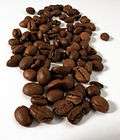Café Touba

Café Touba (Arabic Ṭūbā "Felicity") is a coffee beverage that is a popular traditional drink of Senegal.
Café Touba is a coffee drink that is flavored with grains of selim[1] (known as Guinea pepper or djar in the Wolof language) and sometimes cloves. The addition of Guinea pepper (the dried fruit of Xylopia aethiopica) is the important factor differentiating Café Touba from plain coffee. The Guinea pepper, imported to Senegal from Côte d'Ivoire or Gabon, and other spices are mixed and roasted with coffee beans, then ground into powder. The drink is prepared using a filter, similar to drip coffee.
Café Touba is named for the holy city of Touba, Senegal. The drink is traditionally consumed by the Islamic Mouride brotherhood as it came to Senegal when the brotherhood's founder, Cheikh Amadou Bamba Mbacké, returned from exile in Gabon in 1902.[1][2] The drink is served during ceremonies, commemorations, and during the Magal of Touba.[3]
In recent years, consumption of Café Touba has been increasing as the drink is spreading to cities of all faiths, both in and outside Senegal.[4] The World Bank wrote that a progressive elimination of imported coffee seems common in poorer areas of Senegal as a result of the global recession of 2009: a Senegalese restaurant owner stated, "We weren't used to consume [sic] the Tuba Coffee for breakfast, but since the crisis people drink it a lot, also children."[5] Commercial export outside Senegal, while small, is present.[6] In Guinea-Bissau, Café Touba has become the country's most popular drink, even though it was relatively unknown several years ago.[7] Consumption of Café Touba increased to the point that sales of instant coffee, most notably Nescafé, decreased in West Africa. To more directly compete with Café Touba, Nestlé launched a product that contains spices, called Nescafé Ginger & Spice.[8]
See also
-
 Coffee portal
Coffee portal
References
- 1 2 BBC Afrique (15 August 2012). "Café Touba, du bonheur plein la tasse" (Reprint) (in French). seneweb.com. Retrieved 1 January 2013.
- ↑ Sophie Bava et Cheikh Guèye, "Le grand magal de Touba. Exil prophétique, migration et pèlerinage au sein du mouridisme," (in French) Social Compass, 2001.
- ↑ Amar Samb, "Touba et son "magal"" ; Bulletin de l'IFAN, (in French) vol. XXXI, series B, no. 3, juillet 1969, p. 733-753.
- ↑ Ross, Eric (2011). Globalising Touba Expatriate Disciples in the World City Network. Urban Studies. 48(14): 2929−2952.
- ↑ Heltberg, Rasmus; Hossain, Naomi; Reva, Anna, eds. (2012). Living Through Crises: How the Food, Fuel, and Financial Shocks Affect the Poor. New Frontiers of Social Policy. Washington, DC: World Bank. p. 223. doi:10.1596/978-0-8213-8940-9. ISBN 978-0-8213-8940-9. OCLC 769421434. Retrieved 4 January 2013.
- ↑ Firdaws Café Touba. "Café Touba en ligne" (in French). Villeneuve d’ascq, France. Retrieved 2012-09-05.
- ↑ Allen Yero Emballo. Guinée-Bissau : le café touba, une boisson appréciée [Guinea-Bissau: Café Touba, an appreciated drink] (radio) (in French). Guinea-Bissau: Radio France Internationale. Retrieved 4 January 2013.
- ↑ Hocquet, Anne (28 June 2011). FMCG multinationals in Africa: An illustration of the BoP debate (PDF) (Thesis). Supervised by Christine Rodwell. HEC Paris. p. 15. Retrieved 4 January 2013.
Cheikh Guèye, « Entre frontières économiques et frontières religieuses : le café Touba recompose le territoire mouride », in Jean-Luc Piermay et Cheikh Sarr (dir.), La ville sénégalaise. Une invention aux frontières du monde (in French), Karthala, 2007, p. 137-151. ISBN 978-2-84586-884-7.
External links
- Café Touba : Une consommation très galopante, L'Office (in French), 7 September 2007.
- Le "café Touba", un concurrent de taille à Nescafé, Le Soleil (in French), 26 September 2007.
